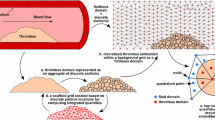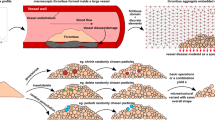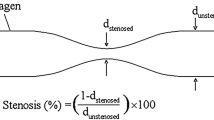Abstract
The flow of blood past an axisymmetric thrombus analogue, within an in vitro geometry, is computed via solution of the discrete three-dimensional (3D) Navier–Stokes equations. Particle tracking is used to model the behaviour of thrombocytes (platelets) moving throughout the domain and to investigate behaviour with respect to the platelets. The system is explored using shear rate to quantify the effects an idealised thrombus has with respect to an undisturbed in vitro geometry over ‘Poiseuille flow’ shear rate conditions applicable to in vivo and in vitro experiments (1,200–10,000 s−1). Local shear rate variations show peaks in shear rate greater than double that of Poiseuille flow conditions. These local shear rate variations are observed to be non-linear, despite the low Reynolds number (5.2–43.4) within the system. Topological transitions of shear rate are observed, limiting the height of peak shear rate within the system, suggesting a thrombus growth limiting behaviour. Temporal gradients of shear rate, measured with respect to individual platelets, were calculated. Multiple regions of peak shear rate gradient were observed throughout the flow, suggesting that platelet–platelet interaction may not be limited to regions near to the surface of the thrombus.







Similar content being viewed by others
References
Akima H (1970) A new method of interpolation and smooth curve fitting based on local procedures. J ACM 17(4):589–602
Andrews RK, Berndt MC (2004) Platelet physiology and thrombosis. Thromb Res 114(5-6):447–453
Blackburn HM, Sherwin SJ (2004) Formulation of a Galerkin spectral element-Fourier method for three-dimensional incompressible flows in cylindrical geometries. J Comput Phys 197(2):759–778
Born GVR (1977) Fluid-mechanical and biochemical interactions in haemostasis. Br Med Bull 33(3):193–198
Brass L (2009) In the shadow of the thrombus. Nat Med 15:607–608
Coppola G, Sherwin S, Peirò J (2001) Nonlinear particle tracking for high-order elements. J Comput Phys 172(1):356–386
Dopheide SM, Maxwell MJ, Jackson SP (2002) Shear-dependent tether formation during platelet translocation on von Willebrand factor. Blood 99(1):159–167
Eisenberg PR, Ghigliotti G (1999) Platelet-dependent and procoagulant mechanisms in arterial thrombosis. Int J Cardiol 68:3–10
Furie B, Furie BC (1988) The molecular basis of blood coagulation. Cell 53(4):505–518
Goncalves I, Nesbitt WS, Yuan Y, Jackson SP (2005) Importance of temporal flow gradients and integrin αIIbβ3 mechanotransduction for shear activation of platelets. J Biol Chem 280(15):15,430–15,437
Karniadakis GE, Israeli M, Orszag SA (1991) High-order splitting methods for the incompressible Navier–Stokes equations. J Comput Phys 97:414–443
Ku DN (1997) Blood flow in arteries. Annu Rev Fluid Mech 29(1):399–434
Kulkarni S, Dopheide SM, Yap CL, Ravanat C, Freund M, Mangin P, Heel K, Street A, Harper I, Lanza F et al (2000) A revised model of platelet aggregation. J Clin Invest 105(6):783–791
Kulkarni S, Nesbitt WS, Dopheide SM, Hughan SC, Harper IS, Jackson SP (2004) Techniques to examine platelet adhesive interactions under flow. Methods Mol Biol 272:165–186
Maxwell MJ, Westein E, Nesbitt WS, Giuliano S, Dopheide SM, Jackson SP (2007) Identification of a 2-stage platelet aggregation process mediating shear-dependent thrombus formation. Blood 109(2):566–576
Nesbitt WS, Westein E, Tovar–Lopez FJ, Tolouei E, Mitchell A, Fu J, Carberry J, Fouras A, Jackson SP (2009) A shear gradient-dependent platelet aggregation mechanism drives thrombus formation. Nat Med 15(6):665–673
Papanastasiou T, Georgiou G, Alexandrou A: Viscous fluid flow. CRC Press, Boca Raton (2000)
Rodkiewicz CM, Sinha P, Kennedy JS (1990) On the application of a constitutive equation for whole human blood. J Biomech Eng T ASME 112:198–206
Savage B, Almus-Jacobs F, Ruggeri ZM (1998) Specific synergy of multiple substrate–receptor interactions in platelet thrombus formation under flow. Cell 94(5):657–666
Savage B, Saldivar E, Ruggeri ZM (1996) Initiation of platelet adhesion by arrest onto fibrinogen or translocation on von Willebrand factor. Cell 84:289–297
Sheard GJ (2009) Flow dynamics and wall shear-stress variation in a fusiform aneurysm. J Eng Math 64(4):379–390. doi:10.1007/s10665-008-9261-z
Sheard GJ, Fitzgerald J, Ryan K (2009) Cylinders with square cross-section: wake instabilities with incidence angle variation. J Fluid Mech 630:43–69
Sheard GJ, Leweke T, Thompson MC, Hourigan K (2007) Flow around an impulsively arrested circular cylinder. Phys Fluids 19(8):083601
Tolouei E, Butler CJ, Fouras A, Ryan K, Sheard GJ, Carberry J (2011) Effect of hemodynamic forces on platelet aggregation geometry. Ann Biomed Eng 39(5):1403–1413
Wootton DM, Ku DN (1999) Fluid mechanics of vascular systems, diseases, and thrombosis. Annu Rev Biomed Eng 1(1):299–329
Acknowledgments
The authors thank the Monash eResearch Centre (MeRC) for access to their central compute facility. KR and CJB thank VLSCI for the time granted on their peak compute facility under RAS Grant VR0023. G.J.S. thanks VLSCI for access to their peak compute facility under RAS Grant VR0025, and NCI for access to their National Facility through a Merit Allocation Scheme Grant. NCI is supported by the Australian Commonwealth Government. G.J.S. received financial support from a Monash University Faculty of Engineering Small Grant.
Author information
Authors and Affiliations
Corresponding author
Rights and permissions
About this article
Cite this article
Butler, C.J., Ryan, K. & Sheard, G.J. Haemodynamic forces on in vitro thrombi: a numerical analysis. Med Biol Eng Comput 50, 493–502 (2012). https://doi.org/10.1007/s11517-012-0891-y
Received:
Accepted:
Published:
Issue Date:
DOI: https://doi.org/10.1007/s11517-012-0891-y




